Languedoc Region
1160 Hair Goes Au Naturale
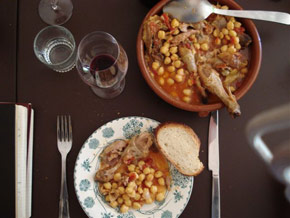

Carole Kotkin is a syndicated Miami Herald food columnist and co-author of “MMMMiami – Tempting Tropical Tastes for Home Cooks Everywhere.” She is also the manager of The Cooking School at The Ocean Reef Club, food editor for “The Wine News” magazine, and co-host of “Food and Wine Talk” on southfloridagourmet.com.

A generous slice of foie gras terrine, accompanied by delectable French bread (still warm), some just picked greens, tiny tomatoes, and for a main dish, Cassoulet—a perfectly seasoned bean casserole filled with sausage, pieces of duck and chunks of ham—all harmonized with a local wine. What could be more perfect for an evening meal in the South of France than foie gras from a local farm, grilled fish caught in the Mediterranean that morning, and vegetables straight from the garden. This, I thought, is why people come to the South of France. Only I wasn’t in that south of France, the one with the yachts docked off the Cote d’Azur and fields covered in lavender. The setting was the garden of Restaurant le Jardin de la Tour, located in a 19th century building in the medieval city of Carcassonne in Languedoc–Provence’s wild, unspoiled western neighbor.
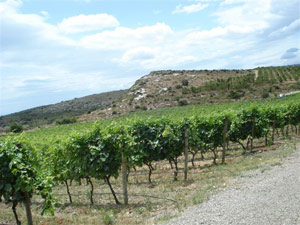
This is a landscape of dry vegetation and rocky overhangs following the curve of the Mediterranean from the Pyrenees at the Spanish border up and around to Nîmes. The Languedoc has prime conditions for grape growing, with its mild Mediterranean climate and a range of interesting soils that provide diverse terroirs for quality wine production. Although wine has been made in Languedoc for more than 2,000 years, the rise in the level of quality is very recent. With over half a million acres, the Languedoc is the largest wine-growing region in France. More wine is produced in this area than in the entire United States. For decades it was France’s bulk-wine-growing region, but it all changed about 10 years ago when bold winemakers, who couldn’t afford land in Bordeaux or Burgundy, discovered the great promise of the Languedoc. Here the terroir offers a combination of arid soil and hot Mediterranean sun that’s perfect for Mediterranean grape varieties, such as Grenache, Carignan, Mourvèdre and Syrah, as well as international varieties, such as Cabernet Sauvignon and Chardonnay. Garrigue (lavender, thyme, rosemary and juniper) growing wild throughout the region is a defining characteristic that universally links wines from this area. Languedoc has always been a region to provide wine for a great value, many of these from the Vin de Pays appellations. But for true quality and value, look for wines from the AOCs (Appellation d’Origine Contrõlée, which translates as “term of origin”– the French certification granted to certain French geographical indications for wines).
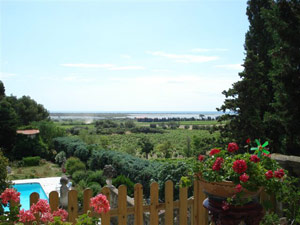
Languedoc wines range from white to red; dry to sweet; still to sparking. Wines from this region are known either by their appellations or by grape variety, creating a bit of confusion for the wine buyer. Low price is no longer the main reason to buy these wines now that the finest Languedoc wines have become credible competitors to their more well-known (but still pricier) cousins from Bordeaux and the Rhone Valley. The top Languedoc wines are being made by vintners who insist on low yields in their vineyards and employ state-of-the-art technology in their wineries. There are about 3,000 such wineries, covering nearly 225,000 acres – roughly a quarter of the vineyards in the region. No French wine region offers as much quality, variety and value as the Languedoc. Thanks to a small group of passionate new producers, these wines are some of the most interesting and delicious in France. Many of these up-and-coming producers have worked at famous estates in Burgundy and Bordeaux, while others were trained by Languedoc pioneers such as Mas de Daumas Gassac (the Château Lafite-Rothschild of the Languedoc).
The following appellations are just a sample (out of the 19 controlled origin appellations, 12 for still wine, 4 for natural sweet wine and 3 for sparkling wine) from the wines I tasted on my recent visit.
Cabardès
Situated between Carcasonne and the Pic du Nore on the stony slopes of the Montagne Noire in the western party of the Lanaguedoc, Cabardès was granted AOC status in 1999. The blending of Atlantic (Merlot, Cabernet) and Mediterranean (Grenache, Syrah) grape creates a richness and enhances the balance of these wines. The appellation is the only AOC in France that permits the blending of these particular grape varieties.Most of the wine produced in the Cabardès is red, but rosé can also be produced under the AOC designation.
What a surprise it was for me to meet former Floridians, Joe and Liz O’Connell and their son, Ryan, owners of O’Vineyards in Cabardès. After giving up their prosperous construction company in Tampa to grow grapes here in 2004, they are now producing more than 5,000 cases of excellent syrah, merlot and cabernet sauvignon. Look for O’Syrah, Trah Lah Lah and Proprietors Reserve. www.ovineyards.com
Corbières
This is one of the largest wine appellations in France. To distinguish the wines, Corbières is divided into 11 terroirs such as Sigean, Lézignan, Boutenac and Lagrasse. Corbières extends west and south of Narbonne, as far as the vineyards of Roussillon, sandwiching Fitou-Maritime between itself and the sea, and partly enveloping Fitou de Hautes-Corbières The red wines, which dominate, are a blend of Syrah, Mourvèdre, Grenache and Lledoner Pelut (together accounting for at least 50%) with Carignan, Picpoul Noir, Terret Noir and Cinsaut. Lesssor quantities of rosé (similar varieties to the red, some different limits on proportions) and white are also produced, the latter comprising Bourboulenc, Grenache Blanc and Maccabeu among others. Several domaines are turning out great value wines here; look out for Ollieux Romanis Corbieres among others.

Côteaux du Languedoc
This is the largest and one of the most significant viticultural regions of the Languedoc running along the Mediterranean coast from the Spanish border up to Nimes, backing up to the foothills of the Montagne Noire. Created in 1985, it is a catch-all appellation, which is in a state of flux. Although at present the region is a mix of terroirs, crus and subregions, wines with true potential are beginning to emerge. Main red grape varieties grown in this appellation include Grenache, Syrah and Mourvèdre along with Cinsault and Carignan. Whites include Grenache, Clairette, Piquepoul, Viognier, Roussanne, and Marsanne.
Twenty years ago there was nothing – not a vine – at Château Puech-Haut in Saint-Drézery. Now it is one of the most successful wine estates in Languedoc, much thanks to the dynamic Gerard Bru and his substantial investments to wine making techniques. Look for 2004 Chateau Puech-Haut Saint-Drezery Rose Prestige. Red Wines (Grenache, Syrah, Mourvèdre) make up 80% of the production.
Hecht & Bannier is a small négociant-éleveur dedicated to wines from Languedoc and Roussillon. Look for Hecht & Bannier Coteaux de Languedoc (as well as Faugeres and Minervois).
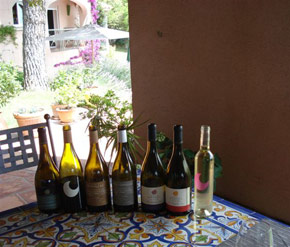
La Clape
This is tiny sub-appellation of Côteaux du Languedoc expects to receive full AOC status next year. La Clape is close to the Mediterranean coast in the Western Languedoc. This small district, comprising rocky slopes of limestone rising directly from the Mediterranean near the city of Narbonne, produces red and rosé wines from Grenache, Syrah, Mourvèdre, Cinsault, and Carignan, and whites from Bourboulenc, also called Malvoisie. The area is protected from mountain breezes by the Carcassonne Valley, and cooled by sea mists below. La Clape’s wines are celebrated : notable names include Mas du Soleilla and Chateau de la Negly. Mas du Soleilla, is a winery owned by a pair of Swiss émigrés to the region, Peter Wildbolz and Christa Derungs. The Clôt de l’Amandier 2005 is their top wine. A blend of old-vine Syrah and Grenache that comes from vines planted in 1954, it was aged 15 months in small French oak barrels. Wildbolz, 54, an enologist who studied in Bordeaux, worked in the Swiss wine industry before buying 37 acres in La Clape in 2002. He was drawn to the region because of its relatively low land prices, and he has since added 25 acres to the winery’s holdings. Wildbolz says that all his grapes are hand-harvested and that yields are low, about 1.8 tons per acre for the reds.
Minervois
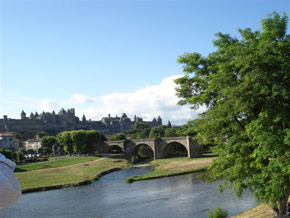
Situated within the triangle formed by Carcassonne, Narbonne and Béziers, the area offers well structured reds of Grenache Noir, Carignan, and Cinsault complemented with Mourvèdre and Syrah—the same grapes commonly found in Rhone wines. For many years, Minervois wine quality was good, but the area did not receive the respect it deserved. However, in 1985, the French wine authority granted Minervois AOC status. Strict regulations were immediately imposed on the vineyards and winemaking techniques were enforced (not to mention gaining instant credibility). The result is dramatic: With its full-bodied and full-flavored reds, the Minervois is the best and most consistent winemaking district in the Languedoc. Whites are made from Grenache, Clairette, Marsanne, Roussanne, and Muscat. Robert Eden, the talented winemaker at Château Maris, has been making quality wines here since 1997. Because the vineyard is farmed organically, no synthetic fertilizers are used, but only compost from cow manure. His La Touge Syrah is a beautiful example of what can be produced in this region.
John Bojanowski of Clos du Gravillas in Saint Jean de Minervois grew up in Kentucky and majored in literature at Brown University before marrying Nicole and becoming a wine maker. Pure Carignan red and Grenache white were the surprise successes of coaxing wines out of the gravel soil. Those wines, Lo Vièlh and L’Inattendu have won consistent high marks by critics, along with his Chateau Cabezac Minervois Belvèze Grand Cuvee 2002.Look also for Chateau La Villatade Rosé 2007 made from 50% Syrah and 50% Grenache
Limoux
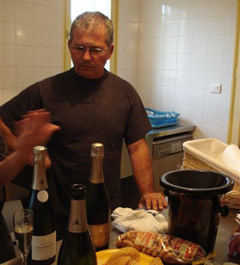
Limoux is a relatively cool zone, which makes it a great place to grow white grapes, particularly Chardonnay. More than a century before champagne, the Benedictine Monks of the Abbey of Saint-Hilaire in the Southern foothills of Limoux had created France’s very first sparkling wine. By 1794 Blanquette de Limoux was well known and appreciated throughout France. At about that time it was discovered by a famous American, Thomas Jefferson. The Third American President was an expert on French wines and Blanquette de Limoux was an integral part of his wine cellar. Over four and a half centuries later Saint-Hilaire Blanquette de Limoux is made in the very same foothills of Southern France.
Based on the traditional method, the Crémant de Limoux of Domaine J. Laurens expresses the terroir. One uncorking and you’ll learn why the French compare Blanquette with their finest Champagne.
Picpoul de Pinet
Picpoul de Pinet, another sub-region of the Languedoc AOC, is a small island of white wine production in a sea of red that stakes its reputation on the 17th century white grape Picpoul. The terroir is a mixture of limestone, sand and clay, that is far more suited to the cultivation of white varieties than red. Only the Picpoul grape qualifies for the terroir – probably soon to have full appellation status – other white varieties, and all red grapes, go into vin de pays or country wine. Two domaines turning out wines eminently suitable for seafood pairings such as oysters are Cave de Pomerol Huges Beaulieu Picpoul de Pinet and Félines Jourdan Picpoul de Pinet.
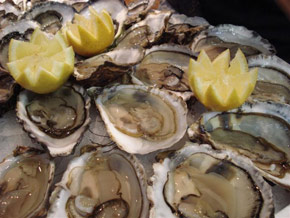
Sights:
History is on display in all its glory in places like the aforementioned Carcassonne, a UNESCO World Heritage Site. This medieval walled city is one of the region’s biggest tourist attractions, with its narrow streets, cathedral and castle. Although the old city is crowded in summer, the mild climate guarantees the area can be enjoyed in all but the darkest months of winter. And it makes a great base to explore the fascinating and often over-looked Languedoc region of South West France
Getting There:
Formerly considered remote from the rest of France, the Languedoc is now served by Air France with flights from Miami to Paris, and a 90-minute daily connecting Air France flight to Toulouse which make the trip in less than 90 minutes from Paris. This comes just as the area is trying to develop itself as a destination for wine tourism, a growing sector combining, as it does, the good things in life – history, culture, food, and stunning landscapes.


